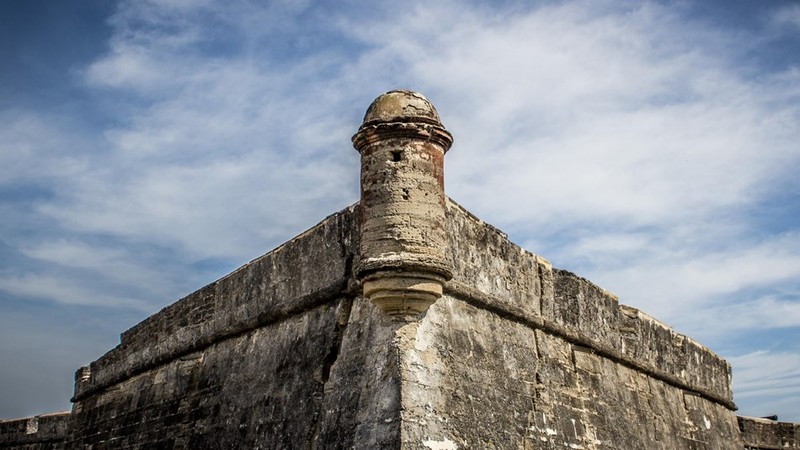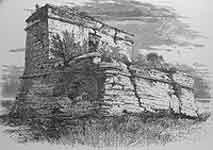Castillo de San Marcos
Introduction
Text-to-speech Audio
Images
The Southwest bastion is part of the original fortification and has stood for over three hundred years

An artist sketched this picture of the fort in 1872. Had it not been for the efforts of preservationists and the support of the government, this historic structure would have succumbed to the elements.

Visitors can tour this reconstructed fort, which contains many elements of the original fort constructed by the Spanish in the 17th century.

Backstory and Context
Text-to-speech Audio
Architecture and Construction
As the “Culture Trip” website states, the Castillo de San Marcos was “built from an indigenous and semi-rare stone composed of the shells of dead shellfish (called coquina)…Unlike other stones, coquina has a compressible nature, absorbing the blasts of projectile cannons rather than deflecting” (“A Brief History of Castillo De San Marcos, Florida”).The distinctive bastion-style construction is an example of engineers adapting to the changing technologies of New World warfare. The star shaped design of the Castillo creates angled walls throughout the fort in order to reduce the likelihood of an enemy cannon being able to hit any of the walls with a straight shot.
The Beginnings Of The Castillo
First English Siege (1702)
The fort saw only two significant attacks, both by British colonial leaders in the early 1700s. In 1702, during the War of the Spanish Succession, the English invaded the town and besieged the castle for 50 days without success. They decided to burn the town before moving out but the fort remained intact, becoming a symbol that links the old and the new St. Augustine. New lines of defense were set in the north and the west.Second English Siege (1740)
Matanzas was not fortified when General James Oglethorpe and the British soldiers from Fort Federica attacked in 1740. The Matanzas’ entrance was blocked and the castle, once again, besieged. The Spanish defenders did not vacillate during the 38 days in which they were besieged by the British. The invasion demonstrated Matanzas’ strategic value and the need to reinforce it, thus the Fort Matanzas was finished in 1742.British Occupation
As a result of the Seven Years’ War, Spain ceded all of Florida to Britain in exchange for Cuba in 1763. The British dominated both fortresses until the end of the American Revolution.Although acquisition of Florida was desired by British military leaders in what would become the American South, British acquisition of Florida occurred only as the result of diplomatic negotiation following the French and Indian War-a conflict where the bulk of the fighting occurred far from St. Augustine. The same is true of the United State's later acquisition of Florida-although slaveholders in Georgia staged several filibustering expeditions into Spanish-controlled Florida, the territory was acquired as a result of negotiation rather than direct conquest.
United States' and Confederate States' Periods
With the Treaty of Paris of 1783, Spain reclaimed Florida and governed it until 1821, when it was ceded to the United States due to international conflicts. The castle’s name was changed to Fort Marion in 1825 and, then, was used as an Indian prison during the Second Seminole War from 1835 to 1842. Native leaders such as Osceola were imprisoned here during that conflict-the longest official war in American history. Although revered by many Americans at the time for his leadership and efforts to negotiate a peaceful settlement, the nature of the Seminole Wars were such that US troops were willing to take extreme actions against Native leaders. As a result, Osceola was captured under a flag of truce and placed in a cell in the old Castillo along with many other Native leaders.In 1861, shortly after Florida voted for secession, Confederate troops took possession of Fort Marion from its lone inhabitant-an army sergeant assigned to take care of the fort. Recognizing its limited value, Confederate leaders moved the fort's cannon to other forts along the Florida coast. In 1862, the Union Navy occupied the area without a major fight and established batteries near the fort that thwarted Southern smugglers from utilizing the rivers and ports of St. Augustine.
In 1898, the fort was last used as a prison for deserters and mutineers during the Spanish-American War.
Restoration
Following the war, the fort continued to deteriorate until preservationists and the federal government worked to restore what remained of the historic fort. “In 1924, President Calvin Coolidge designated the fort as a National Monument, and in 1933 the National Park Service took jurisdiction of it from the War Department. The Park Service continued to maintain the fort as a National Monument” (Carlisle126). As a way to recognize its Spanish heritage, the government reestablished the original name of Castillo de San Marcos in 1942.The fort is currently managed by the Florida State Park Service. According to their website, it is open to the public providing them the opportunity to explore its interiors, learn more about the site’s history, and witness gun firings and live reenactments (“Castillo De San Marcos National Monument”).
Sources
“Castillo De San Marcos National Monument.” National Parks Service, U.S. Department of the Interior, 24 Apr. 2017, www.nps.gov/casa/index.htm. Accessed 22 March 2018.
Carlisle, Rodney P., and Loretta Carlisle. "Castillo De San Marcos (Fort San Marcos)." Forts of Florida: A Guidebook, 2012. Gainesville, FL: U of Florida, 2012. 107-26. Print.
Wallis, Margaret. “Castillo De San Marcos.” Visit St. Augustine, Henry E. Hird III, 1998, www.visitstaugustine.com/thing-to-do/castillo-de-san-marcos. Accessed 22 March 2018.
Wulff, Alexia. “A Brief History of Castillo De San Marcos, Florida.” Culture Trip, 19 Aug. 2016, https://theculturetrip.com/north-america/usa/florida/articles/a-brief-history-of-castillo-de-san-mar.... Accessed 22 March 2018.
